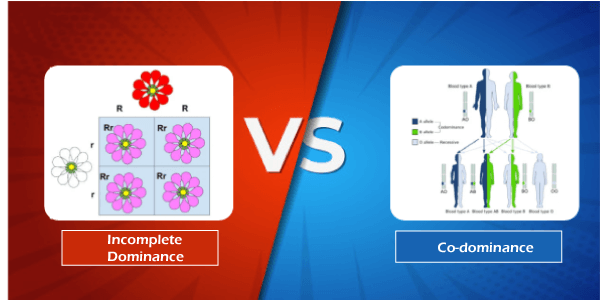Difference between Incomplete Dominance and Co-dominanceWe have all studied different things related to the human body in biology. Biology is a different concept wherein the human mechanism is explained along with its complications and disorders. Everything comes under biology, ranging from various systems in the body to its complications, disorders, diseases, etc. Biology also focuses on the ways in which we can keep our bodies fit. Diseases, be it minor or major, are never-ending; that is why it is essential to keep ourselves healthy at every point of time. Now, let us talk about genes? What are genes, and their functions? Well, a gene is defined as a heredity unit that is used to synthesize proteins, RNA, etc. During the gene expression, the DNA is first copied to RNA. Genes determine the hair color, eye color, etc. There are two terms associated with genes, i.e., Incomplete Dominance and Co-dominance. Now, there are several aspects of differences between them. But let us first begin with the definition of and incomplete dominance and co-dominance. 
Incomplete DominanceIncomplete dominance is the gene interaction that occurs in the heterozygote. In this process, the dominant allele and recessive allele do not dominate one another; rather, a trait appears/ arises in the offspring. This process is also known as partial dominance. For instance, in roses, the allele for red color is dominant over the white color. Similarly, incomplete dominance can also be seen when a white flower and a red flower produce a pink flower. They are not dominant on one another. Now, here arises a question, i.e., do humans experience incomplete dominance? Well, incomplete dominance rarely occurs or does not occur in humans. Humans are complex creatures, and most of the traits occur in the offspring through multiple genes. For instance, parents with curly hair and straight hair produce offspring with wavy hair. Eye color can also be considered as an example for the same. Incomplete dominance can be best understood by the offspring produced by the mixture of the dominant and recessive allele. It is interesting to note that incomplete dominance is a kind of an intermediate inheritance. There are three different genotypes resulting in phenotypes, i.e., RR (red petals), Rr (pink petals), and rr (white petals). In humans, the color of the skin is also an example of incomplete dominance because the dark skin or the light skin cannot dominate over one another. Thus, incomplete dominance is seen in the heterozygote. Co-DominanceCo-dominance is defined as a relationship between two genes. The offspring obtain a particular gene called an allele from both the parents. In co-dominance, there is no recessive allele. Therefore, the phenotypes of both alleles are clearly expressed. Unlike incomplete dominance, in co-dominance, the phenotypes of the parent are visible in the offspring. For instance, a human having an AB blood group. Co-dominance can also be seen in the ecosystem. In ecology, co-dominance is defined as the state wherein the two species are equally dominant. In animals, co-dominance is seen in speckled chicken (having both black and white feathers) and roan cattle (having red and white hair simultaneously). Co-dominance is also seen in plants and humans. In humans, mixed hair color is one of the examples of co-dominance. One of the advantages of co-dominance is that the organisms/ offspring produced are different from the common population, and the organisms have a genetic diversity within them. Co-dominance can be seen by skin color, eye color, hair color, blood group, etc., in humans. When a person has an AB blood group, then this means that the person has both the alleles equally expressed in their body. Now, there are certain differences between co-dominance and incomplete dominance. So, let us discuss the in brief.
So, these are some of the contrasting points between co-dominance and incomplete dominance. Now, there are certain characteristics of incomplete dominance and co-dominance. So, let us have a look at them. Characteristics of Incomplete Dominance
Characteristics of Co-dominance
So, these are some of the characteristics of incomplete dominance and co-dominance. Incomplete dominance and co-dominance can be seen in plants, animals, and humans. These processes are fundamental in all living beings. It is interesting to note that incomplete dominance is rarely seen in humans. Thus, both incomplete dominance and co-dominance are some of the essential processes.
Next TopicDifference between
|
 For Videos Join Our Youtube Channel: Join Now
For Videos Join Our Youtube Channel: Join Now
Feedback
- Send your Feedback to [email protected]
Help Others, Please Share










